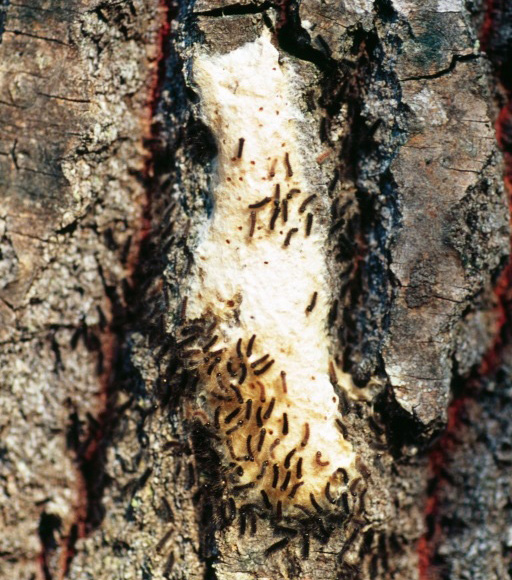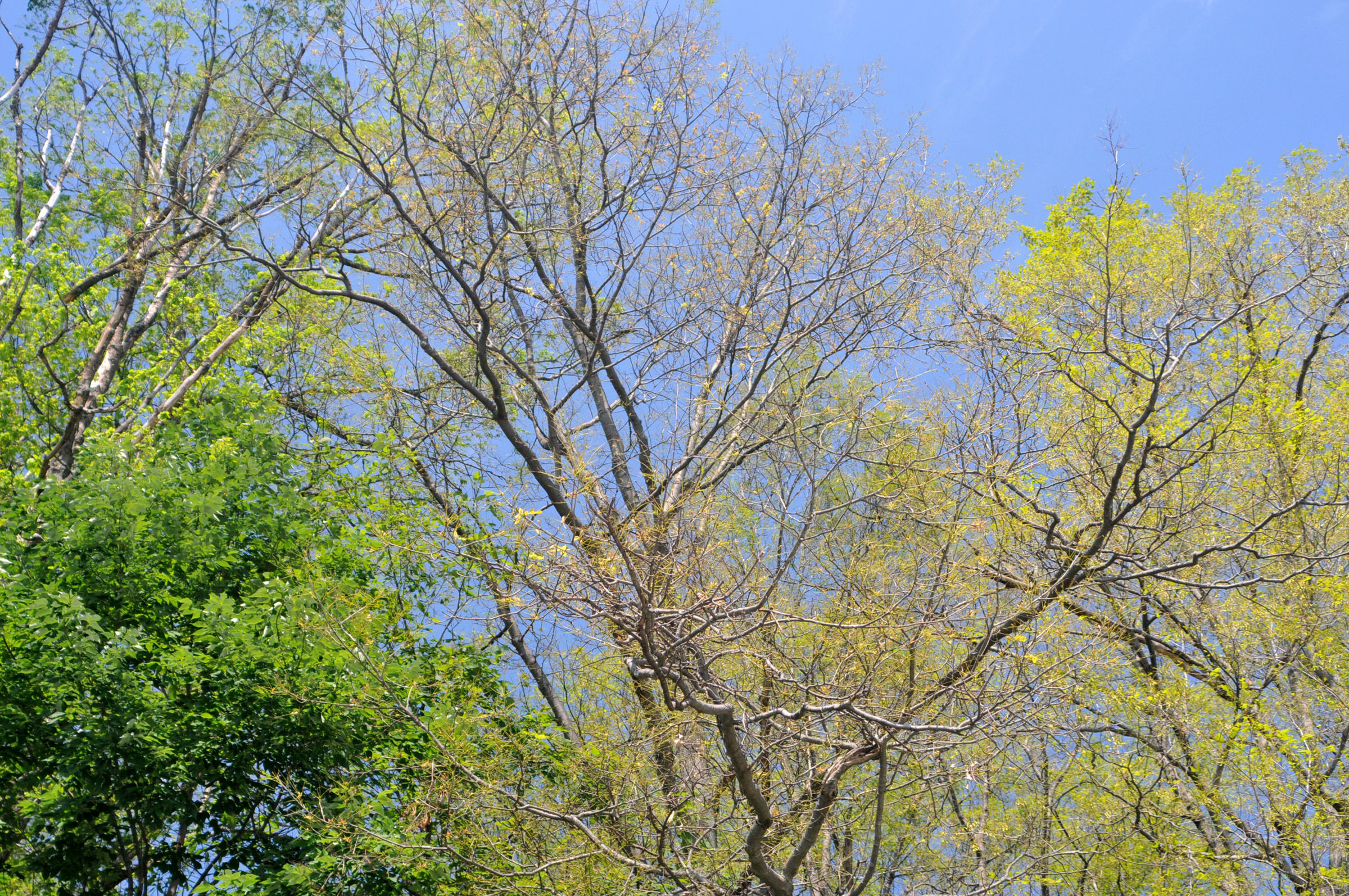Btk: One management option for Lymantria dispar
Answers to frequently asked questions about using Bt products to control Lymantria dispar, formerly gypsy moth, during outbreaks.

Lymantria dispar, formerly gypsy moth, an invasive pest native to Europe, was introduced into Massachusetts in 1869 by a well-meaning, but clearly misguided, amateur naturalist. Despite many efforts to contain this pest, Lymantria dispar populations have continued to expand. People can accidentally move Lymantria dispar egg masses or other life stages into new areas, which greatly increases the rate of spread. Populations of Lymantria dispar are now found across much of the eastern United States and Canada.
Lymantria dispar was first discovered in central Lower Michigan in the 1950s, and the first outbreaks occurred in this area in the mid-1980s. By the late 1990s, much of Lower Michigan and areas in the Upper Peninsula had experienced a major Lymantria dispar outbreak. Today, Lymantria dispar is present in all Michigan counties. During most years, Lymantria dispar populations are low and few people even notice them. Occasionally, however, the density of a local Lymantria dispar population builds to outbreak levels.
Lymantria dispar outbreaks typically last two to four years, then collapse, usually because the caterpillars die from viral and fungal diseases. Parasitoids, predators, starvation and unfavorable weather may also help reduce Lymantria dispar numbers. Once an outbreak collapses, the population will remain low for some time, often several years.
A Lymantria dispar outbreak can be unpleasant for people who live, work or enjoy outdoor recreation in affected areas. Large hairy caterpillars can be abundant in forests, campgrounds and parks, and in residential areas. The caterpillars often wander in search of cool, shady areas, often resting on the sides of houses and trees during the day. Frass (insect feces) produced by the caterpillars feeding on leaves in the tree canopies can rain down on driveways, sidewalks and picnic tables. Oaks and other favorite host trees can be heavily defoliated, usually between late June and mid-July.
Lymantria dispar completes one generation each year. Tiny Lymantria dispar caterpillars hatch from eggs sometime between late April and mid to late May. Newly hatched caterpillars disperse by hanging from a silk strand and waiting to be carried in the wind. The caterpillars feed for six to eight weeks on the leaves of trees in forested, rural, suburban and urban areas. By the time caterpillars finish feeding, they may be 2 to 3 inches long.
Oak trees are usually their favorite hosts, but Lymantria dispar caterpillars can feed on many other hardwood trees including aspen, basswood (linden), willow, birch and crabapple. When populations are high, caterpillars sometimes feed on spruce, pines or other conifer trees. In fact, Lymantria dispar caterpillars can feed on at least 300 different species of trees and woody shrubs.
Hardwood trees (those that lose their leaves in fall) can tolerate two or three years of severe or even complete defoliation if they are reasonably healthy. Often, severely defoliated hardwood trees produce a second set of leaves in midsummer, which allows the trees to build up energy for the next year. Producing the second set of leaves, however, can stress the trees, slowing growth and sometimes making the trees more vulnerable to other pests.
Unfortunately, conifers (evergreens) such as spruce, fir and pine trees cannot produce a second set of buds during the summer. If caterpillars consume all or nearly all the needles on conifer trees, the trees will die.
Though Lymantria dispar is here to stay, there are several options to help control this pest during outbreaks. One option involves spraying Bt to protect tree foliage and reduce the annoyance caused by Lymantria dispar caterpillars. Bt refers to a microorganism called Bacillus thuringiensis. Bt is widely used to control Lymantria dispar and certain other caterpillar pests because of its effectiveness, ease of use and its low toxicity to other animals, including other insects. This article is designed to answer some frequently asked questions (FAQs) about Bt.

What is Bt?
Bt is the abbreviation for Bacillus thuringiensis, a native bacterium commonly found in soil and on plants. Thousands of Bt varieties exist in nature, each with its own unique characteristics. Most Bt varieties are insect pathogens that cause disease in specific groups of insects, and several are registered with the U.S. Environmental Protection Agency (EPA) as microbial insecticides. Though Bt products can be highly effective in controlling specific insects, they have little impact on other animals. Therefore, sprays made with Bt pose much less risk of affecting non-target organisms than conventional chemical insecticide sprays.
The Bt products used to control Lymantria dispar during outbreaks are made from a strain known as Bacillus thuringiensis var. kurstaki HD-1, or more simply, as Btk. Btk has been used for Lymantria dispar control in the northeastern U.S. since 1961 and in Michigan since 1985.
The Btk formulation used for Lymantria dispar spray programs in Michigan is certified by the Organic Materials Review Institute (OMRI), a national nonprofit organization that approves products for organic growers, as regulated by the USDA National Organic Program. Btk is commonly used by organic gardeners and farmers, as well as some conventional farmers, to control caterpillar pests of fruits and vegetables.
How does Btk control Lymantria dispar?
When Btk grows, it produces spores and non-living protein crystals. When Lymantria dispar caterpillars eat leaves that have been sprayed with Btk, the protein crystals dissolve in their digestive system and become toxic. This can occur only in caterpillars because of the many unique conditions present in their digestive system. For example, caterpillars have an alkaline digestive system, while humans and many other animals have acidic digestive systems.
Soon after caterpillars feed on leaves sprayed with Btk, they stop feeding. If the caterpillars consume enough Btk, they die after a few days from a combination of starvation, damage to their digestive system and bacterial growth within their bodies.
There are a few unusual but important things to remember about the way Btk works:
- Btk must be eaten by caterpillars to be effective. Therefore, the leaves of trees or shrubs must be well coated with Btk.
- Young Lymantria dispar caterpillars are usually more sensitive to Btk than older, larger caterpillars. This is one reason why Btk should be applied soon after Lymantria dispar caterpillar eggs hatch. Timing of Btk applications depends on spring weather conditions and varies by location (see MSU’s Enviroweather’s Lymantria dispar treatment guidelines). Older, larger caterpillars may become ill, but can often survive a Btk application.
What are the ingredients in a Btk product?
Commercially available Btk products are composed of two major components: the active ingredients and the inert ingredients. The active ingredients in products used to control Lymantria dispar are Bt kurstaki HD-1 spores and protein crystals. Bt kurstaki HD-1 is a naturally occurring bacterium in the environment.
Inert (non-active) formulation ingredients are added to the Btk spores and crystals. These ingredients make it easier to mix, spray and store the product. These ingredients are food-grade additives that appear on the U.S. Food and Drug Administration’s “Generally Recognized As Safe” list.
How does Btk differ from conventional chemical insecticides?
In contrast to Btk, conventional chemical insecticides are man-made or synthetic chemicals that usually affect the nervous systems of insects and other animals. These products can kill insects on contact or when eaten. This means conventional insecticides are capable of killing most non-target insects, including beneficial parasitoids and predators, and pose greater health hazards to humans and other animals.
How long does Btk last?
Most of the Btk sprayed on tree foliage is destroyed by sunlight and microbial activity within a few days. To help reduce Lymantria dispar populations and defoliation during an outbreak, tree foliage must be sprayed each year, ideally soon after Lymantria dispar eggs hatch.
Does Btk harm other insects?
Btk is much more selective than conventional chemical insecticides, but it can affect other kinds of foliage-feeding caterpillars if they are also feeding on treated leaves. This is a good reason to use Btk only when Lymantria dispar populations are high. Some caterpillar species are more sensitive to Btk than Lymantria dispar, while others are less sensitive. Scientists have studied non-target species of caterpillars following Btk sprays for Lymantria dispar suppression. They found that populations of native caterpillar species tend to recover by re-colonizing areas relatively quickly.
Btk has little or no effect on the large majority of insects, including bees, lacewings, ladybird beetles and other beneficial species. This is a significant benefit of using Btk rather than conventional chemical insecticide products, which are toxic to many kinds of insects.

How safe is Btk for humans?
After 50 years of testing and widespread use, Btk has demonstrated minimal hazards to people and other mammals, birds, fish, beneficial insects and other non-target organisms. To ensure the continued safety of Btk for the public, the EPA administers an extensive system of regulatory safeguards. These include requirements for mammalian and environmental toxicology testing of the Btk active ingredients and formulated products. Quality control procedures are also in place to ensure the safety of each batch of Btk products.
As part of its regulatory function, a reassessment of Btk safety conducted by the EPA confirmed earlier findings, including: “…the lack of any reports of significant human health hazards of the various Bacillus thuringiensis strains…” (EPA document #EPA 738-R-98-004).
Major studies were conducted in New Zealand when populated areas were repeatedly sprayed with Btk to eradicate another introduced pest, the white-spotted tussock moth (1998 Report to the Ministry of Forestry prepared by Jenner Consultants Ltd., Parnell Auckland, New Zealand, to address issues raised in 1995 by Diane Wharton, Society Targeting Overuse of Pesticides, North Vancouver). A key citation in a report on the New Zealand study stated: “…The data support the belief that they [Bt kurstaki products] can be safely used in environments in which human exposure is likely to occur.” However, if you are concerned about your exposure to Btk, remaining indoors during the spray application is a good, common-sense strategy.
Will Btk get rid of ALL my Lymantria dispar caterpillars?
It’s important to realize that a Btk spray will not kill every Lymantria dispar caterpillar on your property. When Btk is applied properly, however, it can help protect your trees from serious defoliation and reduce the annoyance caused by high numbers of Lymantria dispar caterpillars during an outbreak.
Is it possible to buy Btk to spray caterpillars in my own garden?
Yes, several commercially available Btk products can be used to control caterpillars on shade trees, fruit trees or plants in the garden. Both liquid formulations and wettable powders are available from local garden stores. Be sure to follow the directions on the label.
Where can I get more information on Bt?
More detailed information on the use of Btk to control Lymantria dispar caterpillars during an outbreak is available from:
- The U.S. Forest Service’s “Bacillus thuringiensis for managing Lymantria dispar: A review.”
- The Entomological Society of America’s “Is Bt safe for humans to eat?”
Download printable handout of this article
This publication was produced in part with support by the Crop Protection and Pest Management Program 2017-70006-27175 from the USDA National Institute of Food and Agriculture. Any opinions, findings, conclusions or recommendations expressed in this publication are those of the author(s) and do not necessarily reflect the view of the U.S. Department of Agriculture.



 Print
Print Email
Email




